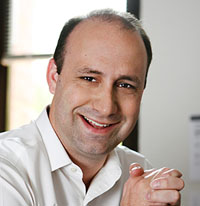A computer scientist at Washington University in St. Louis is part of a collaborative team that is one of four project teams chosen by the National Science Foundation (NSF) to pursue ways to build a more robust, secure and reliable Internet.
Patrick Crowley, PhD, associate professor of computer science & engineering in the School of Engineering & Applied Science, and researchers from nine other institutions received one of NSF’s “Future Internet Architecture” (FIA) program awards to create a new Internet architecture.

Crowley
The four awards are each worth up to $8 million over three years.
Crowley’s collaborative team project, titled “Named Data Networking” (NDN), seeks to design, implement and evaluate a new Internet architecture based on communications primitives that name data instead of machine addresses.
Rather than basing communications on point-to-point connections between computers with IP addresses — as the Internet does today — the NDN architecture is built around requests for and responses to named data, Crowley says.
“It is a radical shift, but one that, we think, enables a qualitatively better path to eliminating redundant network traffic, securing communications, and enabling very large numbers of wireless and mobile devices,” Crowley says.
“NDN routers are dramatically different than IP routers,” says Crowley, who is the only researcher from Washington University on the project and the principal investigator on his part of the project. “The challenges are substantial, but trying to solve them should be a lot of fun.”
Crowley, who received a three-year, $899,996 grant under the FIA program, says his role is to design, evaluate and deploy the routers and switches needed to make NDN a reality.
Lixia Zhang, PhD, professor of computer science at the University of California, Los Angeles, is the principal investigator of the NDN collaborative team.
Van Jacobson, one of the primary contributors to the technological foundations of today’s Internet and a pioneer of the NDN network architecture, also is on the NDN team. He is a research fellow at PARC, a Xerox company in Palo Alto, Calif., and the only commercial organization funded under the FIA program.
“Patrick is one of the world’s leading researchers in high-speed packet forwarding,” Jacobson says. “I’m delighted to be working with him and glad that his expertise and insight will be applied to one of the NDN architecture’s hardest problems.”
The four basic research and system design projects explore different dimensions of the network architecture design space and emphasize different visions of future networks.
NSF anticipates that the teams not only will explore new directions and a diverse range of research thrusts within their research agenda, but also will work together to enhance and possibly integrate architectural thinking, concepts and components, paving the way to a comprehensive, trustworthy network architecture of the future.
The FIA projects include leaders in computer science and electrical engineering as well as experts in law, economics, security, privacy and public policy. The program will support 60 researchers at more than 30 institutions across the country.